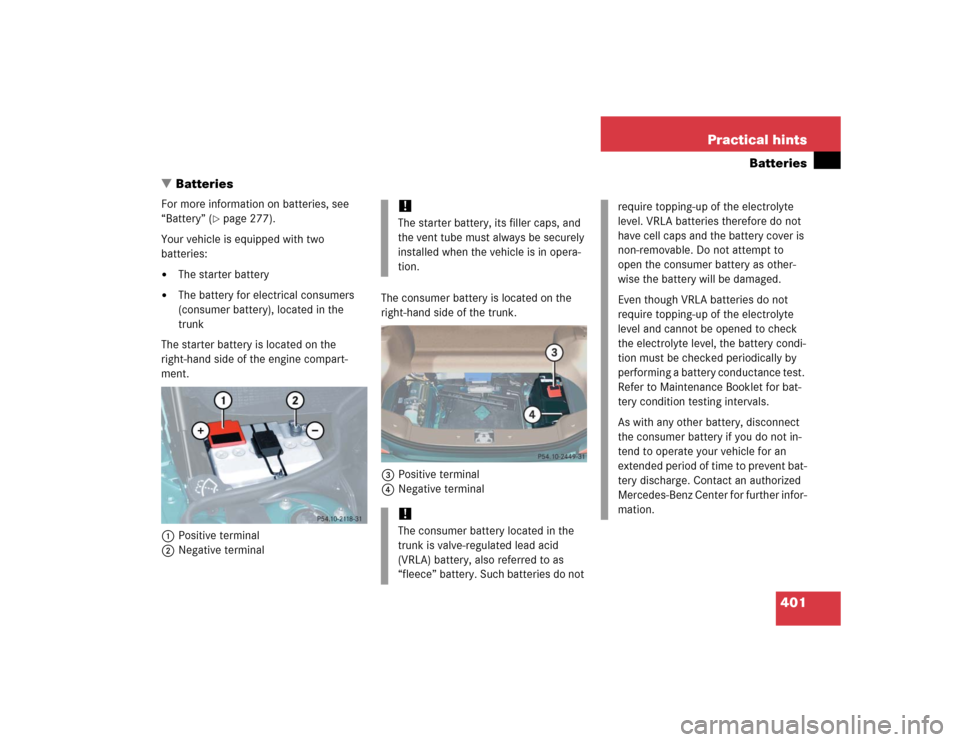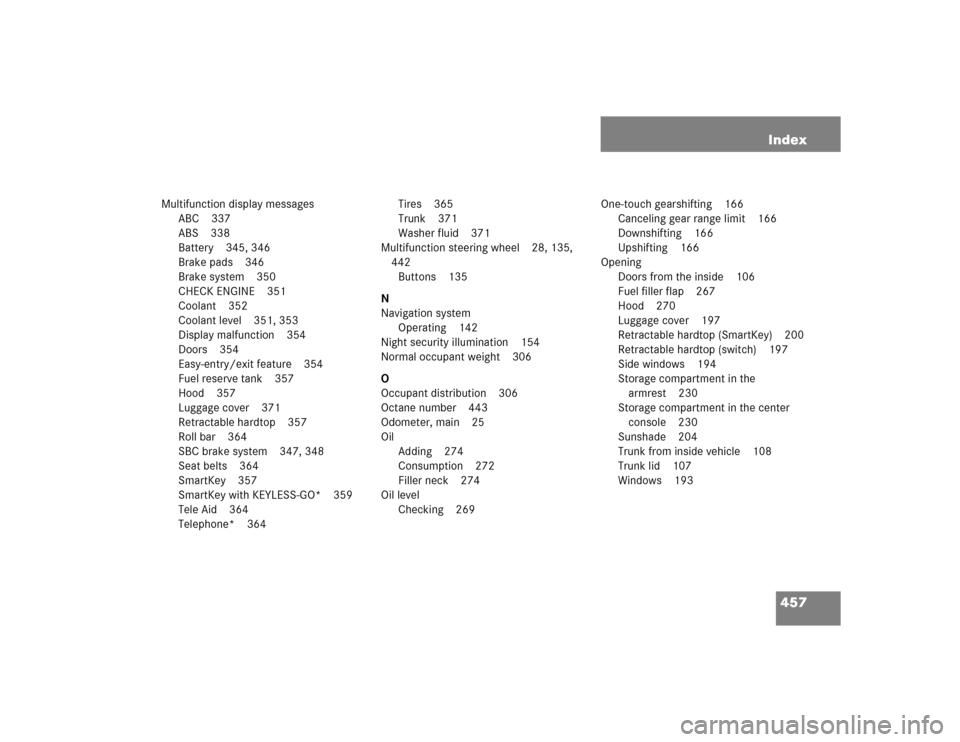Page 266 of 474

264 OperationDriving instructionsPassenger compartmentDriving abroad
Abroad, there is an extensive
Mercedes-Benz service network at your
disposal. If you plan to drive into areas
which are not listed in the index of your
Mercedes-Benz Center directory, you
should request pertinent information from
an authorized Mercedes-Benz Center.Control and operation of radio trans-
mitters
COMAND, radio and telephoneTelephones and two-way radios
Radio transmitters, such as a portable tele-
phone or a citizens band unit should only
be used inside the vehicle if they are con-
nected to an antenna that is installed on
the outside of the vehicle.
Refer to the radio transmitter operation in-
structions regarding use of an external an-
tenna.
Warning!
G
Always fasten items being carried as secure-
ly as possible.
In an accident, during hard braking or sud-
den maneuvers, loose items will be thrown
around inside the vehicle, and cause injury
to vehicle occupants unless the items are
securely fastened in the vehicle.
The trunk is the preferred place to carry ob-
jects.
Warning!
G
Please do not forget that your primary re-
sponsibility is to drive the vehicle safely.
Only operate the COMAND (Cockpit Man-
agement and Data System), radio or tele-
phone
1 if road, weather, and traffic
conditions permit.
Bear in mind that at a speed of just 30 mph
(approximately 50 km / h), your vehicle is
covering a distance of 44 feet (approximate-
ly 14 m) every second.
1Observe all legal requirements.
Warning!
G
Never operate radio transmitters equipped
with a built-in or attached antenna (i.e. with-
out being connected to an external antenna)
from inside the vehicle while the engine is
running. Doing so could lead to a malfunc-
tion of the vehicle’s electronic system, pos-
sibly resulting in an accident and/or
personal injury.
Page 373 of 474
371 Practical hints
What to do if …
Left display
Right display
Possible cause
Possible solution
Ê
Close
trunk lid
This message will appear whenever
the trunk lid is open.
�
Close the trunk lid.
M
Close
trunk partition
You are trying to open or close the
retractable hardtop even though
the luggage cover in the trunk is not
pulled out.
�
Pull out the luggage cover and secure it
(�page 197).
W
Washer fluid
Check level
The fluid level has dropped to about 1/3 of total reservoir capacity.
�
Add washer fluid (
�page 278).
Warning!
G
Do not spill antifreeze on hot engine parts.
Antifreeze contains ethylene glycol which
may ignite when if it comes into contact with
hot engine parts. You could be seriously
burned.
Page 403 of 474

401 Practical hints
Batteries
�Batteries
For more information on batteries, see
“Battery” (
�page 277).
Your vehicle is equipped with two
batteries:
�
The starter battery
�
The battery for electrical consumers
(consumer battery), located in the
trunk
The starter battery is located on the
right-hand side of the engine compart-
ment.
1Positive terminal
2Negative terminalThe consumer battery is located on the
right-hand side of the trunk.
3Positive terminal
4Negative terminal
!The starter battery, its filler caps, and
the vent tube must always be securely
installed when the vehicle is in opera-
tion.!The consumer battery located in the
trunk is valve-regulated lead acid
(VRLA) battery, also referred to as
“fleece” battery. Such batteries do not
require topping-up of the electrolyte
level. VRLA batteries therefore do not
have cell caps and the battery cover is
non-removable. Do not attempt to
open the consumer battery as other-
wise the battery will be damaged.
Even though VRLA batteries do not
require topping-up of the electrolyte
level and cannot be opened to check
the electrolyte level, the battery condi-
tion must be checked periodically by
performing a battery conductance test.
Refer to Maintenance Booklet for bat-
tery condition testing intervals.
As with any other battery, disconnect
the consumer battery if you do not in-
tend to operate your vehicle for an
extended period of time to prevent bat-
tery discharge. Contact an authorized
Mercedes-Benz Center for further infor-
mation.
Page 406 of 474

404 Practical hintsBatteries�
Unhook the luggage cover in the trunk.
�
Remove the trunk floor.
The battery for electrical consumers is
located in the right hand area of the
trunk (
�page 372).
�
Use the 10 mm open-end wrench from
the vehicle tool kit to disconnect the
negative lead from negative
terminal4 of the consumer battery.
�
Open the hood (
�page 270).
�
Use the 10 mm open-end wrench from
the vehicle tool kit to disconnect the
negative lead from negative
terminal2 of the starter battery.
�
Remove the covers from the positive
terminals 1 and 3.
�
Disconnect the positive lead from pos-
itive terminal 3 of the consumer bat-
tery.
�
Disconnect the positive lead from pos-
itive terminal 1 of the starter battery.
Removing the batteries
Removing the consumer battery�
Remove the screws securing the bat-
tery in the trunk.
�
Remove the battery support and
bracket.
�
Take out the battery.
Removing the starter battery
�
Remove the screws securing the start-
er battery in the engine compartment.
�
Lift the retaining bracket.
�
Remove the battery.
Charging and reinstalling batteries�
Charge batteries in accordance with
the instructions of the battery charger
manufacturer.
�
Reinstall the charged batteries. Follow
the previously described steps in re-
verse order.Warning!
G
Never charge a battery while still installed in
the vehicle. Gases may escape during charg-
ing and cause explosions that may result in
paint damage, corrosion or personal injury.
��
Page 459 of 474

457 Index
Multifunction display messages
ABC 337
ABS 338
Battery 345, 346
Brake pads 346
Brake system 350
CHECK ENGINE 351
Coolant 352
Coolant level 351, 353
Display malfunction 354
Doors 354
Easy-entry/exit feature 354
Fuel reserve tank 357
Hood 357
Luggage cover 371
Retractable hardtop 357
Roll bar 364
SBC brake system 347, 348
Seat belts 364
SmartKey 357
SmartKey with KEYLESS-GO* 359
Tele Aid 364
Telephone* 364Tires 365
Trunk 371
Washer fluid 371
Multifunction steering wheel 28, 135,
442
Buttons 135
N
Navigation system
Operating 142
Night security illumination 154
Normal occupant weight 306
O
Occupant distribution 306
Octane number 443
Odometer, main 25
Oil
Adding 274
Consumption 272
Filler neck 274
Oil level
Checking 269One-touch gearshifting 166
Canceling gear range limit 166
Downshifting 166
Upshifting 166
Opening
Doors from the inside 106
Fuel filler flap 267
Hood 270
Luggage cover 197
Retractable hardtop (SmartKey) 200
Retractable hardtop (switch) 197
Side windows 194
Storage compartment in the
armrest 230
Storage compartment in the center
console 230
Sunshade 204
Trunk from inside vehicle 108
Trunk lid 107
Windows 193
Page 463 of 474

461 Index
Service System see Vehicle Maintenance
System
Setting 150
Convenience functions 157
Daytime running lamp mode 152
Digital clock 23
Distronic* time interval 216
Exterior rear view mirror parking
position 158
Instrument lighting 131
Interior lighting delayed
switch-off 155
Key-dependent memory 158
Lamps and lighting (control
system) 152
Locator lighting 153
Lower speed in cruise control 207
Miles/kilometers in
speedometer 148
Multifunction display language 149
Night security illumination 154
Radio station 140
Slower speed in cruise control 207Speedometer display mode 148
Suspension tuning 220
Temperature (interior) 185
Temperature indicator 148
Time (control system) 149
Time display mode 151
Tire inflation pressure units 156
Units
Temperature 148
Tire inflation pressure 156
Units in speedometer 148
Vehicle level control 221
Setting current speed
Cruise control 206
Setting last stored speed
Distronic* 215
Setting speed
Cruise control 207
Distronic* 214
Setting the time (hours) 150
Setting the time (minutes) 151Setting to last stored speed
Cruise control 208
Settings
Calling up Distronic* 142, 212
Convenience functions 157
Factory (SmartKey) 96
Resetting all (control system) 145
Selective (SmartKey) 96
Settings menu
Individual vehicle settings 144
Submenus 145
Shifting
Gear selector lever 164
Gear selector lever positions 168
Into optimal gear range (Automatic
transmission) 166
Shoulder support
Seat adjustment 116
Side air vents 29
Side marker lamps 381, 384